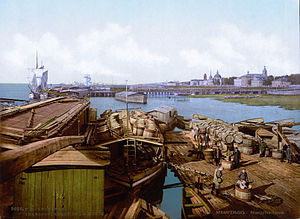

The Pomor trade (Norwegian: Pomorhandel, russehandel; Russian: Поморская торговля) was carried out between the Pomors of Northwest Russia and the people along the coast of Northern Norway, as far south as Bodø. The trade went on from 1740 until the Russian Revolution in 1917.
The pomor trade began as a barter trade between people in the area, trading grain products from Russia with fish from North Norway as the main trade. With time it developed into a regular trade against money: in fact the ruble was used as currency in several places in North Norway. The pomor trade was of major importance both to Russians and Norwegians. The trade was carried out by Russian pomors from the White Sea area and the Kola peninsula who came sailing to settlements and places of trade along the coast of North Norway. The pomors were skilled traders and sailors, and they did also explore the areas around the White Sea. In addition to their trade westwards, they established a trade route east across the Ural mountains to North Siberia.